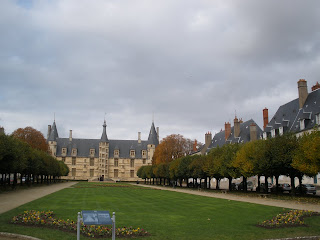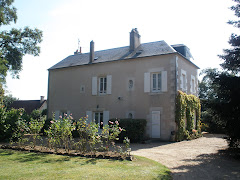




From Nevers, take the Bourgogne regional TRE train two hours to the north on the way to Dijon, and you'll find yourself in Beaune. It's a town that is fairly well known, even in the US, for its vineyards and general beauty. It's in the heart of the Burgundy wine region and is surrounded on all sides by very picturesque
vigne (grapevines). Inside the town are other marks of the wine industry, including many wine production centers, a professional
lycée offering specializations in wine making, and numerous
caves à vin (the name for wine cellars that also designates wine shops). Otherwise, if you've heard of Beaune, it might be for its characteristic Burgundy-region
toitures (rooftops) with colorful shingles providing decoration through imaginative geometric patterns. Or who knows, maybe the students at one of the other
lycées with a tourism degree have succeeded in making their town known
à l'étranger (abroad).
Before arriving in the town on the 17th of October, where I was headed for the weekend to visit fellow assistants Annie Worth, Diana Sibbald and Becca Bonthius and to attend a
salon de dégustation (tasting fair, although really the translation doesn't do justice to the word "dégustation," which includes a whole spectrum of knowledge of flavors and sensitivity to their qualities and pairings), I wasn't sure what to expect. I had heard that Beaune is a beautiful place, but that was about it.
I took the train on Saturday morning after having the house to myself and almost missed the train because I didn't leave the house with quite enough time to make it to
la gare (the train station). Luckily I am quite familiar with Nevers by now and know to take the short route rather than the long route to the station. I ran all the way there and arrived as the train was already in the station.
Chouette (great). Luckily, I caught the train and was able to eat my breakfast in peace and read my book. The fact that I had forgotten my
carte 12-25 (the discount card for passangers aged from 12 to 25 with which I had bought my ticket and which normally needs to be presented upon
contrôle) didn't matter to the conductor. Everything was fine and I had a really beautiful ride through the Burgundy countryside, where the colors have started to change from the green of the fertile fields, vines, and trees to the tans, oranges, and reds of early autumn. When I arrived in Beaune, Annie and Diana were already at the train station, which compared to Nevers' is quite quaint.
La gare de Nevers has a modern entrance way with silver space-aged benches out front in the middle of a gravel esplanade. In Beaune,
la gare has a couple of benches, lots of book stands, and a surprising number of people bustling around. My trip was off to a brisk start, with stark differences already making it a weekend to remember.
To pass the morning, Diana, Annie, and I went to the
marché in Beaune. I must admit that I haven't yet been to the
marché in Nevers, so I won't be able to give a full and detailed
comparaison (comparison) on this point. What I can do is describe the center of town, which is a small open place hidden in a thicket of narrow, winding streets with houses that are just a bit too tall to be friendly lining them. The path from
la gare to
la place goes across the circular boulevard,
la boucle (the ring), I believe it was called. Just on the interior of
la boucle is a grandiose entrance to the town with a large gate and neat bright green topiaries. We passed by lots of up-scale
boutiques (shops) with plenty of
vêtements (clothes),
confisseries (candies), and, of course,
vin (wine).
En se promenant vers la place (While walking to the center), I already noticed the lack of
panneaux "à louer" ("for rent" signs) that give life to the many vacant windows in Nevers. Once we arrived at the hub of Saturday morning activity, the market, the three of us took the time to stroll around, take in the sights, and take a few pictures. The market was especially
vivant, coloré et avait des biens de très bonne qualité (lively, colorful, and had very high quality wares). After looking at
les écharpes en laine, les feuilles de salade ondulées, les fromages crémeux et les fruits de toutes les couleurs (wollen scarves, ruffled lettuce leaves, creamy cheeses and fruits in every color), we decided to prepare ourselves a
picnique (picnic) for lunch. I have yet to have a picnic for lunch in Nevers, probably because... nope, I don't have a good reason. We bought a
baguette from a local
boulangerie (bakery) after much deliberation and some cheese at the
marché from a
fromageur (cheese seller) who was very friendly and let us taste everything before we bought it. Then we grabbed some
pommes, saucisson et chocolat (apples, dried sausage, and chocolate) and headed for a little
parc qu'Annie tient à coeur (park that Annie is fond of). The park has a little pond, next to which another group of picnic-ers was already present, munching on their own baguettes. We found a table next to
le manège (the carousel) and set ourselves up. This park, situated right at the edge of a vineyard, was pretty exceptional. Nevers has nothing like it, since as the city disperses into countryside the outside begins to sprawl a bit with bigger discount stores and wider highways. Nevers has one park, where there are benches and a
kiosque (gazebo), but there are no tables, nor is there a pond. Compared to the bustling metropolis of the
chef-lieu du département (basically the county seat) which is Nevers, Beaune felt quite quaint.
Dans tous les cas (In any case), I'll have to have to
faire le marché (go to the market) and have a picnic in Nevers one of these Saturdays so I can compare the experiences.
The rest of the day was spent visiting in Annie's
appartement à l'internat (the apartment she has in the boarding school at her
lycée) and tasting wine and cheese at the
salon de dégustation, and a trip to Sunday Mass in the charming
église collégiale (collegiate church). The wine and cheese event was hosted by the students in the BTS in tourism and wine agriculture in Beaune. Although
au début (at the beginning) there were lots and lots of people and we ourselves were pretty interested in making the rounds, by the time
les halles (the town hall) started clearing out, we were able to converse a bit with the students. They were all very friendly and were happy to explain to us their course of study, their career goals, and what they liked about Beaune. The general consensus from them was that the town was full of friendly people and had a surprisingly active night scene. This compared with the Nevers students was nothing short of
incroyable (unbelievable). My students are very friendly with me, but they all seem to be a bit down about their studies and they certainly are unenthused by Nevers. They always tell me there's nothing to do here, and yet they have no motivation to travel. And yet something about the
étudiants (students) in Beaune put me a bit off. They were maybe too enthusiastic? I guess the ones I met had chosen their discipline well-- they really wanted to make me have a good time during my visit!
Otherwise, to live up to its reputation as a tourist destination, the town must invest a considerable amount of money in its maintenance. As I explained to a couple of people, the town is so clean it's distracting. Instead of noticing its charming architecture, the people who
se promenent (stroll) in the streets, or the beauty of the surrounding countryside, I was fascinated by the
propreté (cleanliness). Of course, the mystery of little passageways, the splendor of the wide views of the valley from the
ramparts (old city walls) and the simplicity of the vines climbing the old stone buildings was all charming, but there was something too nice about Beaune, too polished, too Disneyworld. French country towns are already so nice, what's the reason for inserting a restaurant with dinners at 80 euros minus the wine? Beaune seemed to me personally like a gilded lilly. And yet, when I got of the train at
la gare in Nevers, I can't say I felt like I was returning
chez moi (home). I think that the grounded community in Nevers, even if it takes a while to really get used to it,
me plaît (pleases me) a bit more than the superficiality of Beaune. Beaune is nice to visit, but I think I'll take my time to continue exploring my Nevers land.






















